PSV Eindhoven currently sit 4th in the Eredivisie, within six points of first-placed Feyenoord. The departure of key players like Cody Gakpo and Noni Madueke to Liverpool and Chelsea respectively may have left PSV with a lower level of quality in their general play, but head coach Ruud Van Nistelrooy has not allowed the standards to drop around the club. Even after losing €80 million worth of talent, PSV remain near the top of the Eredivisie and look to be part of the title race as we approach the final nine matches of the season.
A crucial aspect of their high-scoring campaign has been their ability to continuously create high-quality chances through set pieces. PSV have scored 22 goals in all competitions through set plays, with the tally making up around 25% of their total goals scored throughout the season, including their UEFA Europa League campaign.
In this tactical analysis, we will delve into the tactics used by PSV Eindhoven, with an in-depth analysis of how they have utilised many different variations of screens to create high-quality chances from corners. This set-piece analysis will look at the reasons behind the different routines used depending on the opposition team’s defensive set-up.
Variations of Screens
PSV have been able to utilise screens in many different ways, with the primary goal of creating space in a specific zone remaining as the core principle throughout every corner. Different defensive set-ups forfeit space in different zones, with PSV’s match preparation allowing them to prepare for and effectively set up to expose any type of defensive shape.
The first way in which this was possible, is through exposing exclusive man-marking setups. When teams set up to man mark, it is easy to manipulate the positions of every defender, and therefore create space by simply moving away from the designated target area.
We can see in the example below, every attacker starts deep in the box, with the intention being to attack the front part of the six-yard box. There is plenty of space to attack and deliver the ball into, as a result of Ado Den Haag’s man-marking system. With space to attack, life becomes much easier for the attacking team, with the delivery not having to be as accurate and the attacker doesn’t need as much separation due to there being no defenders challenging for the ball.
Separation allows attackers to gain momentum when attacking the ball, to put more power on the header, as well as allowing attackers to spring higher when competing for the ball. As there is no defender to compete against, attackers only require the slight separation to arrive at the ball ahead of the defender, with a slight contact on the ball to redirect it usually being adequate to cause the goalkeeper trouble.
The vertical white line below displays the screen being set up, with the defender being smothered by the attacker setting up the screen. We can see the screen is like a wall where the line is displayed, preventing the defender from being able to come back to his own goal. As a result, the PSV attacker is able to arrive in the target area (black) without any competition and is able to redirect a header towards goal from around six yards out.
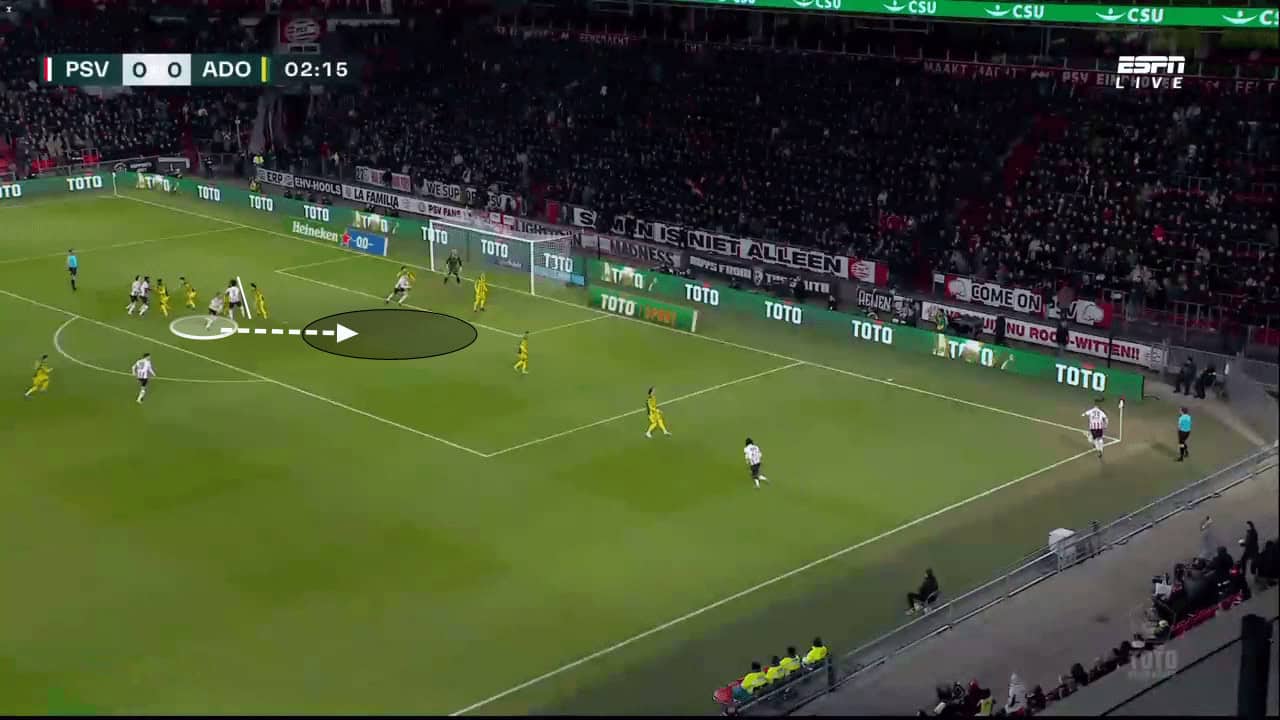
Pictured below, we can see a similar screen used, but against a different defensive system. While most attackers are man marked, it is not possible to mark every single one, with the defending team prioritising defending the space rather than the players. Unlike in the previous example, the entirety of the six-yard box is protected by the yellow shirts, which results in the PSV attackers being left free.
In this sort of scenario, the target area in black is slightly further away from the goal due to the defensive presence, but the attackers are able to attack the ball unopposed in the trade off between two defensive systems. Without a marker, the attacker is able to attack the ball with speed, meaning they are able to put more power into the headed effort. All that’s required for this routine to work, is a simple standing screen on the zonal defenders, to prevent them from being able to step out to clear the incoming deliveries.
The two previous corners display how simple yet effective screens can be, with there being endless possibilities to counterattack against either defensive system a team chooses to use.
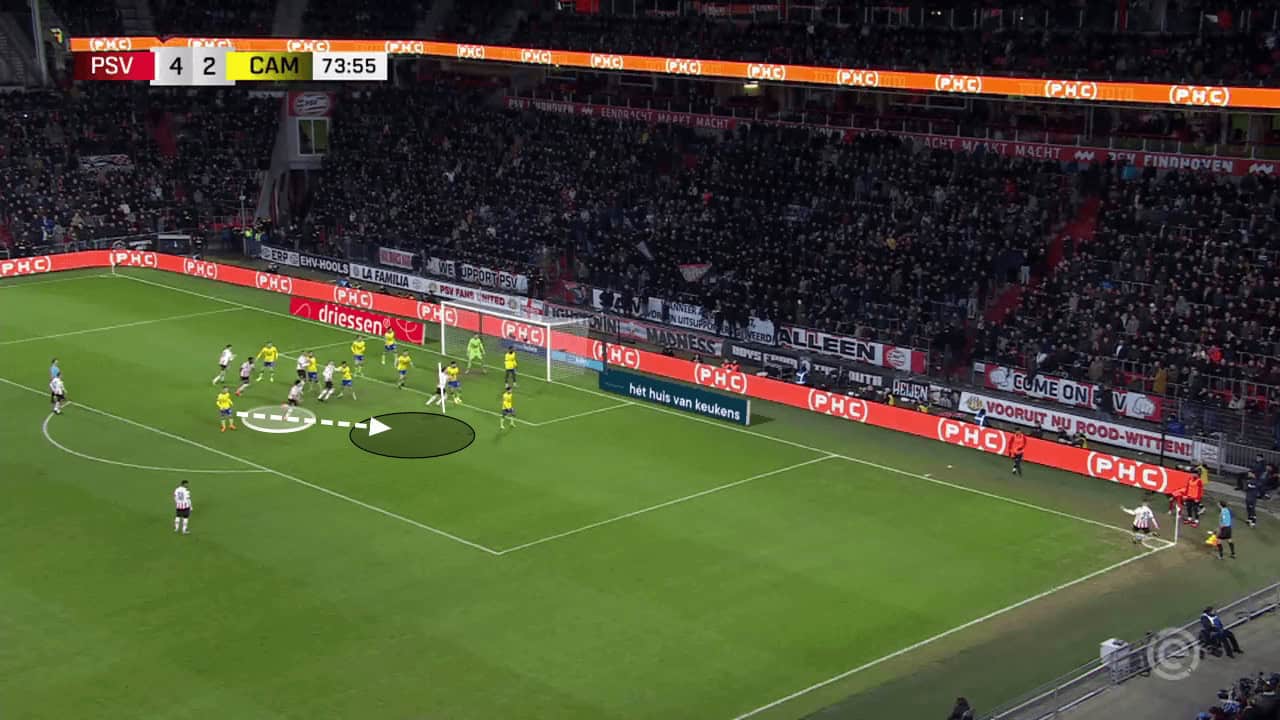
With inswinging corners, it becomes slightly easier for defending players to clear the ball even if it may land in zones around them as it curls back towards them. As a result, PSV attempt to create space in the midst of chaos. We can see in the image below, Feyenoord are man-marking every attacker, whilst also having zonal defenders spread around the six-yard box.
To combat this, PSV attempt to provide attackers with the separation needed to outjump zonal defenders through nullifying man markers. As explained before, an attacker can gain an advantage over a zonal defender if they can attack the ball with momentum as the sprinting jump can help them beat a static defender to an aerial duel. PSV manage to create these scenarios through the use of screens, with blind side screens allowing attackers to gain even more separation than usual.
A screen from the defender’s blind side will catch them off guard, with them having less time to react to the scenario, thus providing attackers with more separation. In the image below, we can see a PSV player screening the defender from behind, and so whilst the attacker moves towards the goal, the defender is forced further away from the goal due to the screen provided.
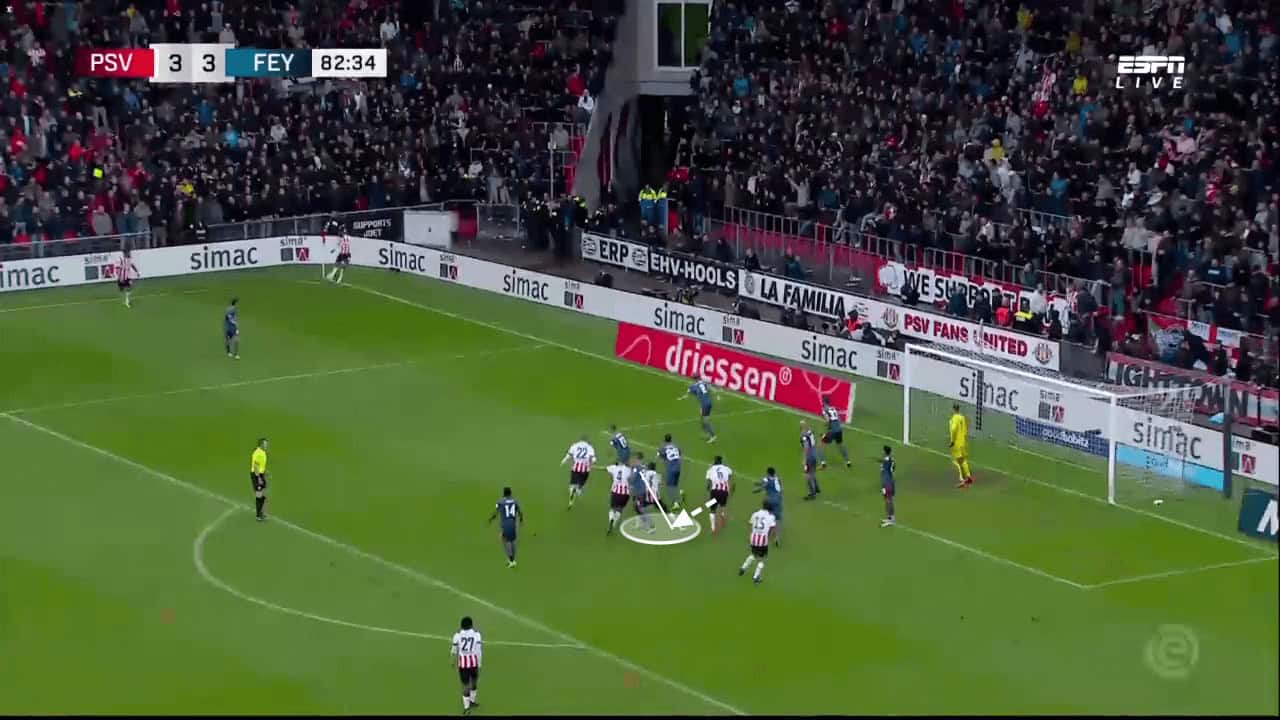
Below, we can see the large distance between the highlighted attacker and defender, with it becoming impossible for the defender to recover in time to compete in the aerial duel. As a result of the separation gained, Obispo (white) is able to use his momentum to out-jump the zonal defenders surrounding him, giving him a headed opportunity from around the six-yard box which he is able to put in the back of the net, giving PSV a late winner in a six-pointer.
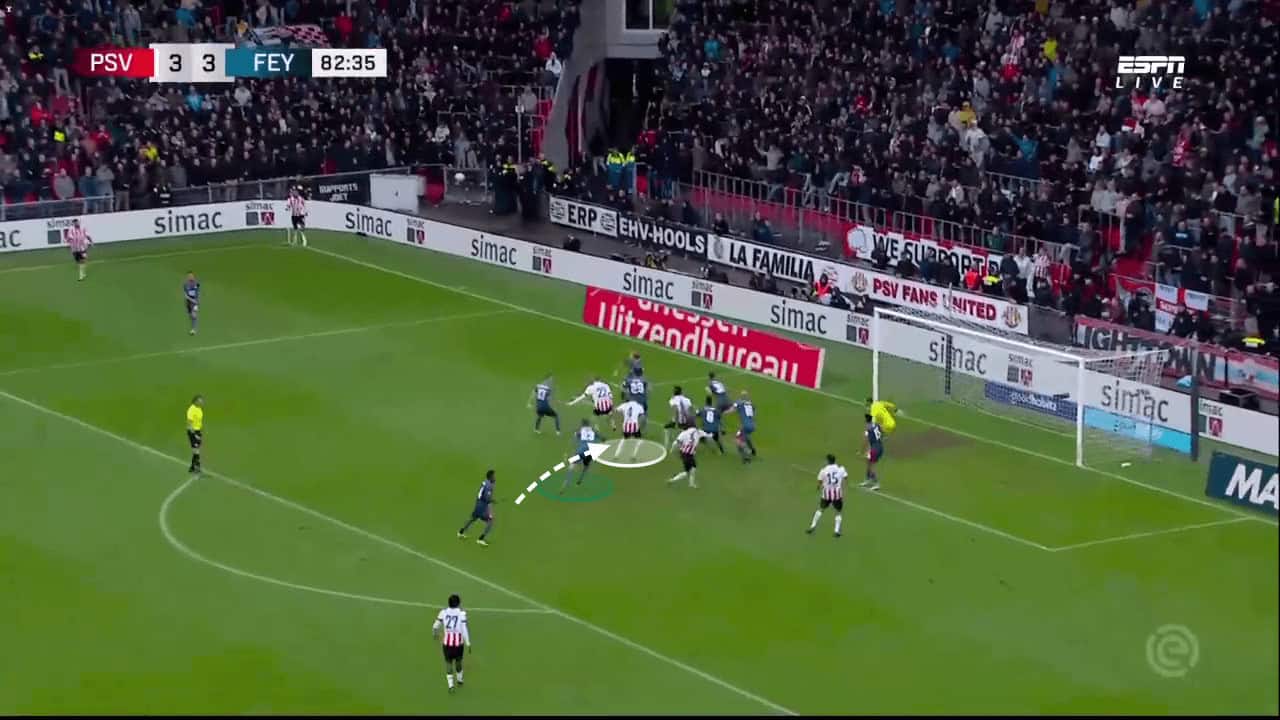
Another method PSV have used to attack open space during corners, is through targeting the back half of the penalty area. With every player inside the box man-marked and zonal defenders making up the numbers around the six-yard box, space is created on the far side of the penalty spot. It is extremely difficult to cover every part of the penalty area adequately, and so there will always be options for the attacking teams to penetrate open spaces during set plays.
In this example where the defensive team is extremely deep and compact around the six-yard box, PSV leave one attacker slightly deeper to attract a defender, making the large open area seem more protected than it is. With just one defender, it can be easy to take them out of the game through the use of a screen, especially from the back whilst their eyes focus on the ball. The white line in the diagram shows the angle of the screen, with the area behind the white line being completely open as the screening attacker forces the defender into the cluster of players in the six-yard box. As a result, ex-PSG and Barcelona prospect Xaxi Simons is able to make a volleyed effort on goal from around 12 yards out.
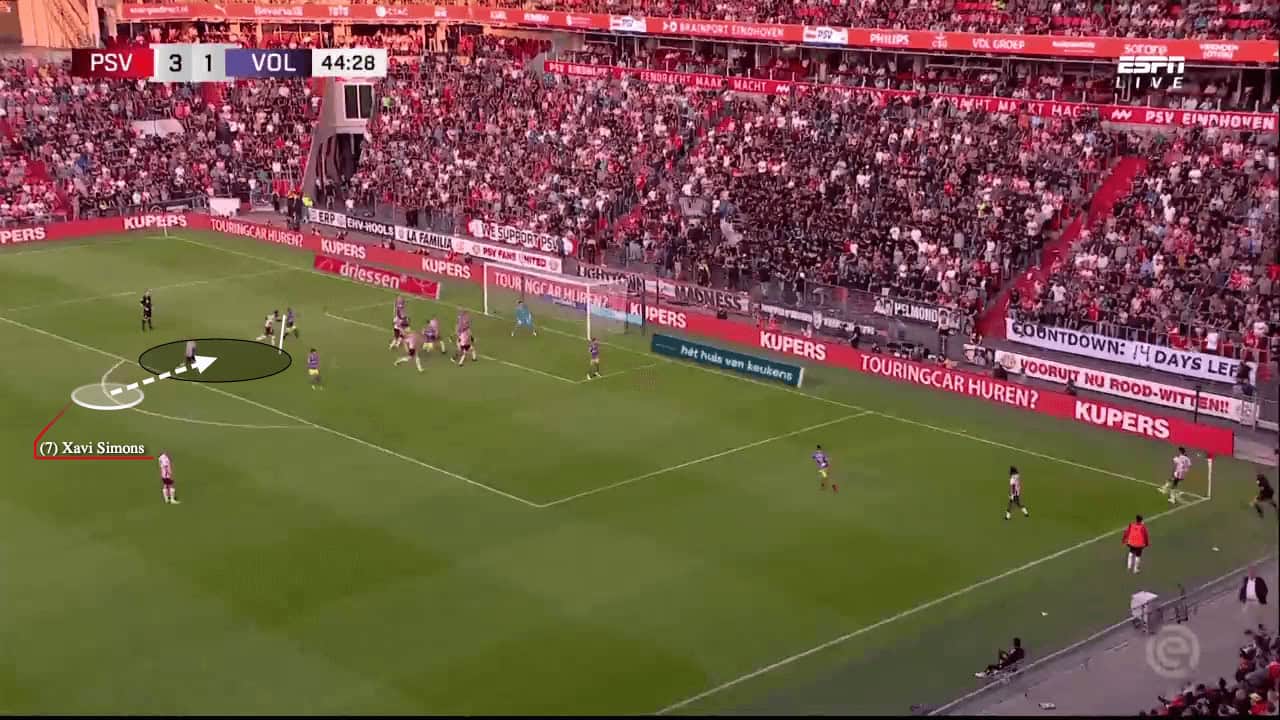
PSV Eindhoven have also been able to use screens to create safe passages for the ball to arrive through, rather than directly vacating space for an attacker to arrive into. To make this clear, we can see in the diagram below, a PSV attacker at the front post, setting up a screen to prevent the zonal defenders from clearing the ball. In previous examples, PSV would have used the screen as an opportunity to attack the ball directly at the front post. However, a slightly different tactic they have used is to allow the ball to pass through the entirety of the six-yard box in order to attack the ball at the back post.
In previous articles, we have explained the benefits of attacking the ball at the back post, with the main benefit being that as defenders ball watch, players are able to lose their markers at the back post in an easier way.
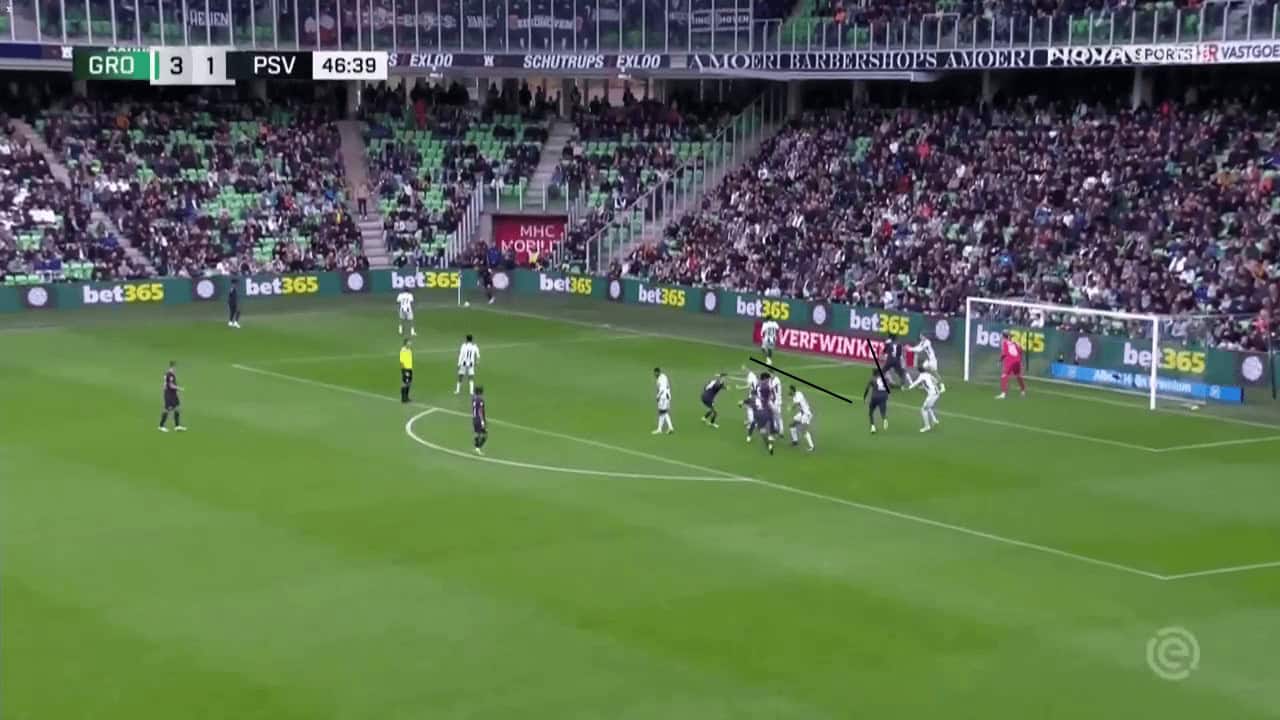
The diagram below shows two PSV attackers making opposite movements, with the run towards the back-post being extremely difficult to track, as the defender can’t see both the ball and the player. As the defender can’t just grab the attacker through the risk of giving away a penalty, the attacker is able to arrive at the back post earlier than his marker, and thanks to the screen by the front post, the ball is allowed to arrive at the back post with little trouble. As a result, the attacker is able to attack the ball freely, although this method runs the risk of a goalkeeper coming out to claim the delivery.

The final way in which PSV have used screens to their advantage is through short corner routines. When the ball is played on the floor, it can lead to dangerous opportunities even if the ball is further away from the six-yard box. One way in which PSV have been able to feed the ball into open areas inside the box on the floor is through screens during ‘open play’ after the short corner has been taken. One player is usually tasked with closing down each attacker to prevent numerical overloads and PSV have been able to take advantage of this by screening one defender who usually closes the ball down, giving PSV the numerical advantage around the box.
In this example below, we can see the attacker on the ball being closed down by a defender, but Cody Gakpo is inside the box unmarked as his marker is being blocked off by another screen. As a result, Gakpo is allowed to turn inside the box and take a shot on goal from within 12 yards.
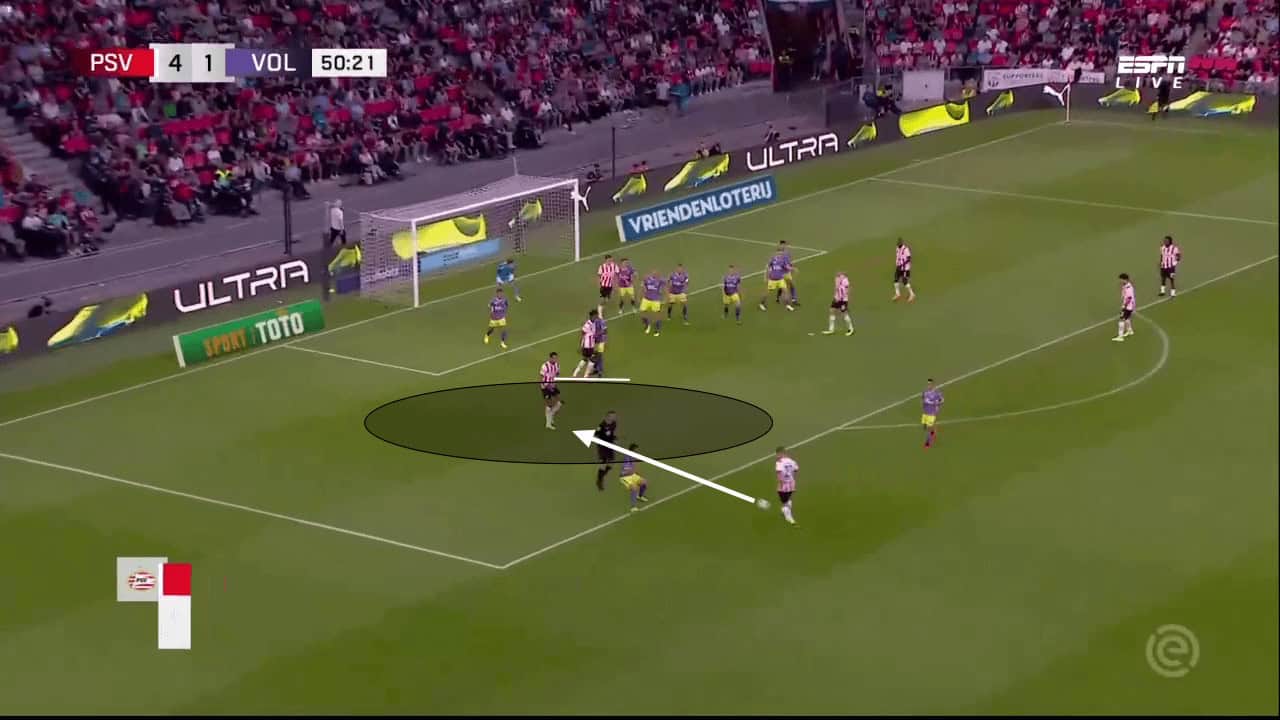
Summary
This tactical analysis has highlighted the numerous ways in which PSV have utilised screens in a highly effective manner.
Being able to identify the open space in the moment is hard enough for some teams, but PSV’s ability to identify available space and coordinate screens efficiently is incredibly impressive and shows a lot of time has been spent on attempting to perfect some of these routines.
Cody Gakpo’s departure may have left a dip in quality and consistency of these corners, but the ideas and principles remain the same nonetheless.






Comments